Food & Agriculture
Where are we now?
It has become increasingly clear that the challenges to local and global agriculture, largely due to climate change, are growing. It is becoming more and more difficult to feed the growing population of the world, to reduce poverty – especially in rural areas, and to mitigate environmental impacts on vital ecosystems. Our society is now faced with the question of how to reconstruct our currently unsustainable food and agriculture industry. In recent years, those seeking to improve the food and agriculture industry and its population-feeding capabilities have noticed that it is impossible to remedy one aspect of the industry without addressing the rest of it. Thus, it has become clear that a more holistic, systems-based framework is necessary to analyze and address the complex issues of the food system from the growing of food to the disposal of it.70
Oxford University’s Future of Food defines the Food System as “a complex web of activities involving the production, processing, transport and consumption [of food].”70 In order to achieve a more sustainable and just food system the issues of governance and economics of food production, sustainability and food security, the quantity of food waste produced, how food production impacts the environment, and its impact on human health all must be addressed. The vulnerabilities of the food system from weaknesses in local and global supply chains to increasing biodiversity loss, are becoming more difficult to ignore. The deepening of the global food crisis has led to a push from grassroots organizations, scholars and local politicians to incorporate food security into policy across Canada and the world.71
What is Food Security/ Food Sovereignty?
According to the United Nations’ Food and Agriculture Organization (FAO), approximately 2.37 billion people globally were food insecure in 2020. This is almost one third of the world’s population. In Canada, approximately 4.4 million people were food insecure in 2017-18, which is approximately 1 in 8 households.72 The FAO defines food security as existing when “all people, at all times, have physical, social and economic access to sufficient, safe and nutritious food that meets their dietary needs and food preferences for an active and healthy life.”73 Following this, British Columbia and Canada have recognized food security as a key public health issue and have made moves to create government programs aimed at improving secure access to food for Canadians.
Kate Feldman discusses food security in the face of climate change, the social determinants of health, and locally grown food initiatives (3:49)
There are, however, many critics of this definition of food security. Scholars Wittman et. al. argue that it “invites an interpretation towards food related policies that emphasizes maximizing food production and enhancing food access opportunities, without particular attention to how, where and by whom food is produced.”71 This lack of attention allows for the perpetuation of the financialization of the food system when instead the focus should be on returning the control of productive resources like land and water to farmers, rather than intermediaries which are often large corporations.71 Thus, the term “food sovereignty” has gained much traction in recent years as a more just understanding of issues within the food system. It uses a systems-based approach to put small-scale farmers and other food producers at the centre of the food system while emphasizing the connections between environmental and community health.
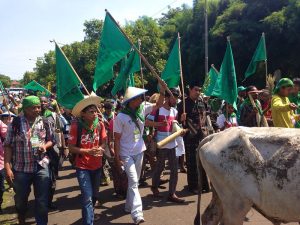
La Via Campesina, a global movement bringing together small- and medium-scale farmers, agricultural workers and peasants aiming to change unjust and unsustainable models of food production, defines food sovereignty as “the right of peoples to healthy and culturally appropriate food produced through ecologically sound and sustainable methods, and their right to define their own food and agriculture systems.”.74 According to the FAO, approximately one third of the world’s food is produced by smallholder farmers in rural areas and many of these farmers often have a very difficult time making ends meet.75 In fact, in Canada, the realized net income of farmers has stayed around zero since the 1980s.76
Kate Feldman discusses the importance of food sovereignty and establishing sustainable control over local food systems (4:21)
Prioritize the collective good of local populations in decisions of land and resource use
According to Statistics Canada, 1 out of every 50 Canadians, or 2% of the total population, work on farms.77 Our current food system controlled by large intermediary corporations, however, tends to distance consumers and their money from those who actually grow their food. This distance leads to consumers being less connected to the food they eat and the land it’s grown on as well as our smallholder farmers facing growing economic insecurity. The push towards food sovereignty seeks to solve these issues by valuing food providers, shortening supply chains and localizing the control of food systems.
Case Study: Indigenous Food Sovereignty in the Arctic
With food insecurity disproportionately affecting Indigenous populations in Canada, food sovereignty has been highlighted as a way to address this challenge as well as signifying an important step towards decolonization. Food sovereignty aims to link production to consumption and emphasizes both the people and the power inherent in food systems, something that the area of food insecurity does not cover.78 Food sovereignty also seeks to fulfill the cultural and spiritual needs that food can provide.79
The Arctic and other areas of Northern Canada have the highest rates of food insecurity in the country, where almost half of these populations report experiencing some level of food insecurity. This is mainly driven by two factors; price inflation of food at the grocery store and restrictions on harvesting food from the land, which is common among the Indigenous populations of the region.80 Consequently, there exists a reliance on external supply chains, creating detrimental trickle down effects for both the consumer and the environment. The price of store-bought food can cost over three times that of the same product in an urban centre due to high transportation costs, this is particularly true for fresh produce and meats.81 And, because of restrictions on locally grown and hunted food, there is a considerable environmental impact as a result of these food transportation requirements. 82
As such, increasing food sovereignty in the north is a potential solution to mitigate food insecurity.82 This looks like restoring rights and increasing self-determination for Indigenous groups to partake in seal and caribou hunting, which are an important part of some cultures in the North.82 Sustainable and subsistence hunting in conjunction with wildlife preservation and land protection can support Indigenous food sovereignty while minimizing the impact of the cultural practices. 80 This approach should also include an awareness of and respect for the impact of stolen land at the hands of the Canadian government. The forced relocation and assimilation of many Indigenous peoples included structures put in place to require Indigenous peoples to abide by Western practices, rendering traditional ways of living no longer viable and subverting traditional means of food procurement and sustainability.
Due to the warming global temperatures, the north has experienced the effects of ecosystem disruption most severely.83 The ice that was formerly used for hunting and fishing has become too thin and the changing climate has altered animal migratory patterns making the subsistence hunting no longer dependable. The challenges posed by climate change mitigate the potential positive impact of Indigenous food sovereignty. As a result, populations in the north are forced to be reliant on unaffordable, unhealthy, and spiritually unfulfilling foods.84
Why is Food Security Crucial for Community Health?
A community can be seen as the ecosystem in which people live. From ecology, we know that if one part of the ecosystem is in disrepair or poor health, the whole ecosystem can be affected. One of the most important elements impacting the health of an ecosystem is the food chain, or food system. As researchers Wakefield et. al. explain “access to sufficient nutritious food is central to life and growth, and being confident that adequate food is available reduces stress and can reduce other adverse health outcomes.”77
Access to food thus plays a key role in ensuring community health because food security is a fundamental precondition for ensuring human health. Research has found that food insecurity often results in ongoing health problems, both short and long term, especially in children. People living in food-insecure households are often reported to have weaker physical health as well as being more vulnerable to a number of chronic health conditions including diabetes, high blood pressure, heart issues and arthritis as well as mental health issues, among others.72
PROOF, a Canadian food insecurity policy research organization, explains that “even after adjusting for other well-established social determinants of health, such as education and income levels, the healthcare costs incurred by a severely food insecure adult in Ontario are more than double that of a food secure adult.”72 This research suggests that reducing food security could significantly decrease expenditures on health care, lessen the burden on the healthcare system and improve overall health in Canadian communities (Figure 3).
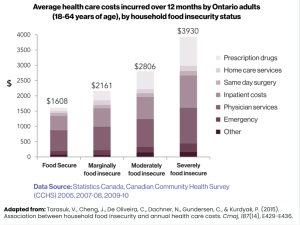
Food insecurity also makes communities more vulnerable to various shocks whether these be supply chain or climate-change related. Extreme weather events such as torrential rain which leads to flooding may cut off a community from the larger supply chain or devastate local agriculture.85 As the American Public Health Association explains, “food system impacts are unequally distributed, with the greatest costs (health effects and health-related costs, low wages, stressful conditions) borne by food producers and other workers, rural communities, and low-income consumers.”86 Thus, it is important to protect those most vulnerable.
Social safety-nets and local food security initiatives are important strategies that can increase community resilience to such events. Food security initiatives and policy allow communities to better adapt to their changing environment as ecosystem disruptions become increasingly common, as well as to fight for justice within the food system.
Case Study: Healthy Kimberly
Kimberly is a rural community in Southeastern BC located between the Purcell and Rocky Mountain ranges. With a local population of approximately 8100, Kimberly’s economy relies heavily on its ski tourism industry.87 Kimberly was especially affected by the COVID-19 pandemic, particularly in its residents’ secure access to food as economic stability diminished. Healthy Kimberly, a community organization offering services from a food recovery project to health and food literacy programs, was able to aid many of its community members during this difficult time. The organization seeks to promote local, community-based action to improve access to healthy activities and food security.88
The Food Recovery Depot opened in November of 2021 and has since recovered more than 195,000 lbs of foods that would otherwise have been sent to landfill.89 The Depot collects food products grocery stores and other distributors no longer can sell but are still perfectly good for consumption and then distributes it to vulnerable members of the community, giving them access to healthy foods – like dairy, produce and meats – at no cost. The Depot also contracts chefs to use much of the recovered food to make frozen meals which can then be distributed to those in need.89 Initiatives like the Food Recovery Depot are finding innovative ways to tackle both local food insecurity and waste management for a more sustainable future.
Dr. Ilona Hale discusses how Healthy Kimberley began, the values that are important to their work, and ways the organization supports the community (4:49)
Climate Change and Food Security
Climate change is one of the greatest ecological, economic, and social issues facing society today. As environmental conditions progressively worsen across Canada and the world, extreme weather events have become more frequent and the reliability of seasonal weather patterns is in decline. Extreme and unpredictable weather events include droughts, hurricanes, cold snaps, torrential rain, and heat waves – often leading to devastating floods and forest fires.85 These all negatively impact our food distribution networks as well as the fragile growing conditions required by food crops. These are both essential for ensuring local, national and international food security.
More specifically, climate disruptions cause the destruction of precious agricultural lands leading to reductions in production as well as raising food prices for consumers. Simultaneously, climate disasters lower incomes in vulnerable, often rural, areas that are dependant on agriculture.90 In order to cope with the growing challenges to agriculture and food security posed by climate change, it is essential to advocate for an agricultural and food system in which mitigation and adaptation to climate change are at the forefront in order to build a sustainable and food secure future.
The Agro-Food Supply Chain
The agro-food supply chain refers to the processes and stages that our food products traverse from their production to their consumption. Before the industrial revolution, the food supply chain was kept very short by factors such as the short “shelf life” of most foods before the introduction of refrigeration and preservatives. Traditionally, food was both grown and consumed locally with the food products being produced on local farms, sold directly to consumers or at local markets and consumed within the same region.
The Industrial Revolution introduced drastic changes to how we produce food products as well as where and to whom we sell them. Over time, food supply chains have become very long and fragmented, largely disconnecting consumers from the sources of their food. Today’s food supply chain is highly complex and comprises many processes including: production, transport, processing, marketing, distribution, and consumption – among others.
It is important to note that each step of the chain requires a large amount of labour as well as natural resources – fossil fuels in particular – which calls into question the sustainability of the food system. Industrial agriculture, for example, requires high levels of fossil-fuel based inputs, such as fertilizers and pesticides. In fact, scholars Horrigan et. al. from the Johns Hopkins Bloomberg School of Public Health report that the food production system accounts for 17% of fossil fuel use in the United States further explaining that “the average U.S. farm uses 3 kcal of fossil energy in producing 1 kcal of food energy.”91
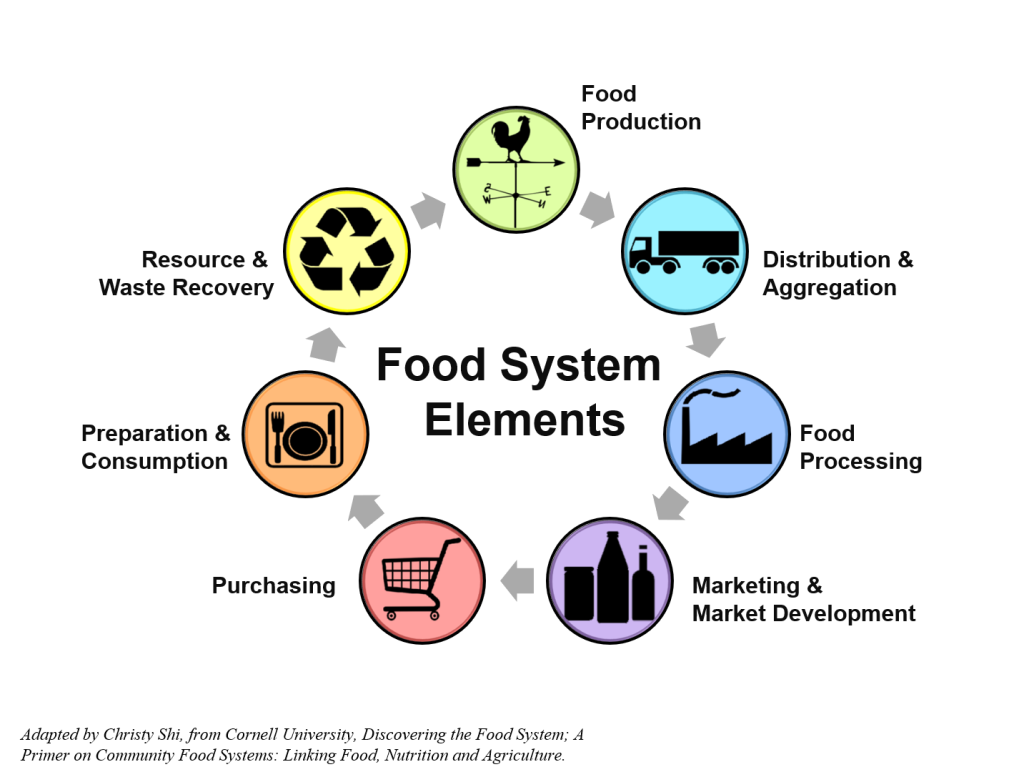
The COVID-19 pandemic has caused many global supply chain issues, particularly due to labour shortages associated with high infection rates and lockdowns, which brought to public attention the fragility of our global supply chain system. Particularly, it has become very clear that when one part of the system is negatively impacted, the whole system suffers. An important example of this is that of China which has, in recent decades, become a superpower in global trade, dominating exports of raw materials such as metals as well as many manufactured goods like electronics and textiles.92
Since the onset of the COVID-19 pandemic, China has faced widespread lockdowns in an effort to eradicate the virus within the country giving rise to labour shortages and leading to a contraction of production in factories as companies reduce and even stop their activities. For example, numbers of workers in Chinese ports were at one point cut in half in order to prevent an outbreak in the entire workforce.93 This led to widespread disruptions in the supply of raw materials and components as well as significantly increasing costs and shipping times of goods essential for production in many industries across the globe, such as chemicals necessary for x-ray machines.93 In his article, “Understanding Supply Chain Disruptions During the COVID-19 Pandemic,” scholar Federico Suárez Ricaurte explains that “as the largest exporter of goods in the world, and Canada’s second-biggest trading partner, any meaningful alteration in China’s patterns of production, distribution or consumption of goods has global consequences.”93
These supply chain issues have important implications for food security as they impact prices of household goods all over the world. As Ricuarte explains “the FAO Food Price Index—a measure of the monthly change in international prices of five commodity groups—reached a 10-year high in 2021.”93 This is a concerning reality as it can create great difficulties for people in low-income households when purchasing necessary goods, such as food. The prices of coffee and oats, for example, doubled following supply chain issues and similar trends can be seen in lumber, cotton, palm oil and wheat prices.93
A more local example of a supply chain disruption is the flooding which occurred in BC’s Lower Mainland following an atmospheric river which made landfall over two consecutive days in November 2021. This uncommon weather event resulted in two days of intense precipitation following weeks of drought in the region, resulting in damaging floods and landslides causing bridge collapses and road washouts. These hazards led to closings of most major highways, pipelines and rail lines across BC’s Lower Mainland, effectively cutting Vancouver off from the rest of Canada for several days, with some roads and highways out of service for weeks after.94
In their article “Human influence on the 2021 British Columbia floods,” scholars Gillet et. al. detail that “the insured losses from this event [cost] 450 million Canadian dollars, making this the most costly weather extreme in the province’s history, but notes that the overall financial losses will be much higher, in part because many residents impacted by the event were not insured.”94 While the economic costs were high, the social costs were devastating. Roads and infrastructure across the region were washed away completely, large swathes of farmland were left underwater – killing thousands of farm animals and destroying livelihoods, over 1000 homes were flooded, more than 3,300 people were displaced and, tragically, five lives were lost.95 Further, this climate event made clear the vulnerabilities of BC’s food system as flooding devastated essential agricultural land in the Lower Mainland and cut off major transportation routes leading to empty shelves in grocery stores in many communities as supply shortages and transportation blockages became widespread.
As climate change progresses, major climate events with disastrous effects, like the occurrence of an atmospheric river, become increasingly common. It was found in a study by scholars Gillet et. al. that “Atmospheric river events of this magnitude are approximately one in ten year events in the current climate of this region, and that such events have been made at least 60% more likely by the effects of human-induced climate change.”94 The results of their study, alongside the long-lasting catastrophic effects on human and environmental welfare demonstrate the grave importance of not only mitigating climate change’s effects but also developing measures to increase resilience to major ecosystem disruptions in BC and globally.
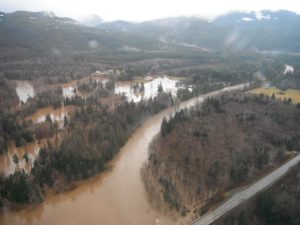
The globalized nature of major supply chains, our agri-food supply chains in particular, are extremely vulnerable to ecosystem disruptions like the spread of infectious diseases, such as COVID-19, or human-induced climate change events, such as the atmospheric river which shocked BC in 2021. These major events also function as urgent warnings that as climate change progresses, Canada’s food system will only become more fragile as the proportion of our food being imported from far away continues to grow and devastating climate change-related events become more common.
Those particularly at risk are people with low incomes who cannot afford to cope with food staples rising in price unpredictably as well as rural communities which increasingly rely on urban centres and the roads to and from their ports for much of their food supply. It is vital that we increase our efforts to mitigate climate change-related disasters as well as begin to increase the resilience of our food systems, which many experts argue must be done by focusing on localizing food supply chains, among other strategies, rather than importing goods from further and further away. In more simple terms, as our world and its climate continue to change drastically, we must also change our systems accordingly, with resilience being our priority.
Conventional Agriculture and Climate Change
The predominant agricultural system today is known by different names: “conventional”, “modern” and “industrial”. While industrial farming systems vary between farms and places around the world, they share several common traits, many of which aggravate climate disruption because of how they consume fossil fuels, water and topsoil at rates that are unsustainable.91 These common traits include large-scale farming operations, monocultures, rapid technological innovation, and the extensive use of synthetic pesticides, fertilizers and herbicides, among others. Further, where livestock is involved, systems include highly concentrated and confined animals as well as high use of antibiotics.96 While conventional agriculture has been developed to drastically increase the efficiency of farming, this efficiency comes at a very high cost to the environment and poses an increasing challenge to food security.
In terms of specific causes of environmental degradation from conventional agriculture, the list is long. An important aspect of this farming model is the use of monocropping (only producing one crop), especially when done at a large scale. It is detrimental to agroecosystems as this practice slowly depletes soil of all necessary nutrients for healthy plant growth.97 In turn, this decline in soil health forces farmers to use larger amounts of chemical fertilizers. The decline in soil quality is also impacted by the effects of heavy tillage of fields using heavy machinery, causing soil compaction. Tilling, which is commonly done in excess, further exposes soil to wind and water erosion, heightens nutrient loss and reduces essential soil microbiology.98
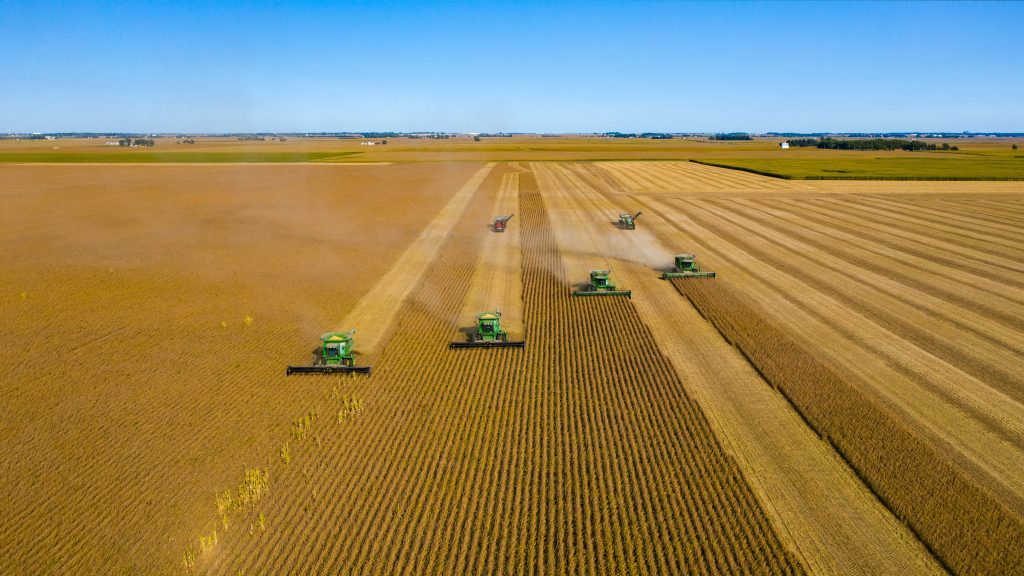
Another major factor contributing to environmental decline is the often intense use of chemical pesticides and fertilizers, high in nitrates and phosphorus. The environmental costs of these chemicals are high with pesticides being very detrimental to biodiversity, especially pollinator populations, like bees, which are essential for crop production. Further, heavy rains wash chemical fertilizers with high concentrations of nitrogen and phosphorus into fresh waterways causing, among other issues, overgrowth of algae, slowly leading to a significant decline in freshwater and marine ecosystems.99 Reduced water quality impacts aquatic populations, such as fish, as well as drinking water.96
Finally, as more and more land, such as forested areas or grasslands, become cleared for agricultural purposes, such as livestock grazing, studies are finding elevated levels of carbon dioxide and other greenhouse gases in the atmosphere.96 It is now well known that soil can act as a “carbon sink” which is a natural body that can absorb and store carbon through the process of carbon sequestration. As we destroy natural landscapes and deplete soils, this natural process is reversed and carbon is released.100
In recent years, scientific research on how the industrial model of agriculture is significantly contributing to climate change is becoming mainstream. More and more, we are understanding the nuances of how our land management practices are not sustainable. This is especially concerning as it becomes more and more unclear how we will feed a growing global population while we continue to deplete soils, marine and agro-ecosystems, without which any food production is impossible.
Salina Edwards discusses the impacts of climate change on rural farming in her community (2:05)
Human Health and Conventional Agriculture
Conventional agriculture, it has been found, can have severe impacts on the health of not only natural biodiversity, but also on the health of human communities often causing both acute and chronic diseases.91 Specific health risks posed by conventional agricultural practices include, among others, the use of synthetic and toxic chemicals, the excessive use of antibiotics, and the accompanying risk of increased prevalence of antibiotic resistant bacteria. Scholars Horrigan et. al. in their article “How Sustainable Agriculture Can Address the Environmental and Human Health Harms of Industrial Agriculture,” describe conventional agriculture as “a factory with ‘inputs’ (such as pesticides, feed, fertilizer, and fuel) and ‘outputs’(corn, chickens, and so forth). The goal is to increase yield (such as bushels per acre) and decrease costs of production, usually by exploiting economies of scale.”91 Human health easily becomes eclipsed in this system which prioritizes profit at all costs.
Factory-style animal agriculture associated with conventional agriculture has led to the proliferation of public health issues such as chronic diseases associated with animal-based diets, largely unrestricted antibiotic usage which may contribute to antibiotic resistance as well as greater risk of food-borne pathogens associated with contaminated animal waste. In reference to chronic diseases associated with meat consumption, Horrigan et. al. describe that “a dietary pattern that contains excessive intake of foods high in calories, fat (especially saturated fat), cholesterol, and sodium, but that is low in complex carbohydrates and fiber, is one that contributes significantly to the high rates of major chronic diseases among Americans.”91
Alongside the excessive use of antibiotics in this style of animal agriculture, which evidence shows, contributes to the progress of antibiotic-resistant bacteria often contained in animal waste.101 Salmonella, for example, causes more than 3 million food-borne infections every year in the United States. While this bacteria is naturally occurring in chickens, it can cause serious health issues in humans, sometimes even leading to deadly outcomes. According to Horrigan et. al. overcrowding in animal industrial livestock production increases the likelihood of contamination and difficulty in detecting this contamination.91
The excessive use of synthetic and toxic chemical fertilizers and pesticides is another major concern for not only the environment, but for public health. Horrigan et. al. explain that “Human exposure to pesticides can come through residues in food—either on or within fruits and vegetables, or in the tissues of fish and animals we eat—through contaminated drinking water, and through the air we breathe (because of “pesticide drift” from the spraying of fields or lawns).”91 Major health issues caused by exposure to such chemical inputs include elevated risk of certain cancers as well as issues with both the reproductive and endocrine systems.91
The risk of negative health outcomes related to chemical input use is particularly high in rural areas where a higher proportion of the population work in or live near agricultural operations using such inputs. In particular, the American Public Health Association (APHA) notes that, “Multiple studies have shown substantially elevated rates of respiratory conditions among workers and community members living near such facilities, including elevations in childhood asthma.”86
The use of these harmful chemicals is not just a health issue, but also an economic issue. According to the APHA, two studies have calculated that every year US public health expenditures due to pesticide use are around $1.1 billion based only on acute poisonings, associated illnesses and cancer rates.86 This is a staggering number, especially when considering that there exist alternatives to using these harmful inputs in the agricultural system.
In conclusion, the prevailing system of conventional agriculture not only poses a risk to the health of our world’s natural environment but also to public health, which one might safely assume is actually both directly and indirectly costing billions of dollars worldwide in healthcare. It is clear that the food system, from which humans receive our food and nutrition, is also causing health problems on an unprecedented scale as the system expands in order to keep up with growing demand. It is imperative that we face the current issues in the food system in order to build a healthier, more sustainable world rather than one with polluted waterways and respiratory systems.

